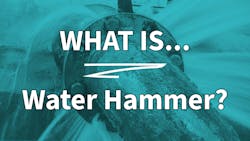What is water hammer?
Water hammer occurs when there is a pressure surge caused by a rapid change in water flow within a pipeline.
An example of water hammer is when a home sink, faucet, shower, bath or water tap is quickly turned off – resulting in the rattling of pipes.
Water hammer isn’t exclusive to the home, and can occur on much larger scales. The same thing can occur for water utilities and their pipes when there’s a rapid change in water flow. This can be caused by water demand, and the opening or closing of valves.
Within the water industry, water hammer can occur from a pump stopping, a check valve closing quickly, or an empty pipe being filled, all of which can send a shocking reverberation down a pipe.
When water suddenly stops or fills an empty pipe it can sound like a hammer knocking on the pipeline, hence the name.
How do you fix water hammer?
Water hammer can be fixed using many different methods.
Some of these methods can be applied at both small and large scales, think of homes vs. water utilities. Some methods to fix water hammer are as follows:
Home
- Install water hammer arrestors: Water hammer arrestors can sit along or on the pipes to absorb the shock and prevent the pipes from shaking.
- Adjust pressure: Water pressure can be lowered to help reduce water hammer. A water pressure adjustment valve can also be installed.
- Secure loose pipes: Loose pipes can be properly secured to reduce the vibration of pipes when water hammer occurs.
- Turn off water slowly: Abruptly turning off water flow can cause a pressure surge down the pipe that causes water hammer. By turning the water off slowly it eases pressure.
- Insulate pipes: Insulating pipes can help with shock absorption from water pressure.
- Create air chambers: By draining and refilling your pipes you can create new air chambers that may mitigate water hammer.
Utilities
- Slowly close valves: Utilities can prevent water hammer by slowly closing valves. Check valves, for example, can snap shut quickly and cause water hammer.
- Program pumps: Programming pumps to ramp up or down gradually to distribute pressure over time can cut down on water hammer.
- Use air intake valves: Air intake valves allow air to enter the system when the pressure drops.
- Hydro-pneumatic tanks: These tanks can be used to store water and provide compressed air to absorb the shock wave.
- Silent and non-slam check valves: These valves close when the differential pressure decreases, rather than closing from reverse flow.[1]
What is the main cause of water hammer?
The main cause of water hammer in water systems is by fast-acting solenoid valves, like check valves, suddenly stopping the flow of water. The sudden stop of flow results in a shock wave that is sent along the pipe causing them to vibrate and knock.
The main cause of water hammer in a high-pressure water system at home is when a tap is quickly turned off. This can be caused almost anywhere that water is available at a home whether it be a washing machine quickly turning off water, or turning off a hose at a spigot quickly.
How do you know if you have water hammer?
The easiest way that water hammer can be identified is by sound.
Water hammer generates a knocking sound that is similar to hitting pipes with a hammer. The water pipes can vibrate and move around due to the change in water flow and pressure. They can vibrate against surfaces if they’re lose and cause a knocking sound.
Water hammer can also be identified by a vibration in pipes. Even if the pipes don’t make any sound when water is quickly shut off, they may still vibrate due to changes in flow and pressure.
Water hammer in larger water systems, such as utility plants, can take on a similar effect but on a much larger scale.
It can generate moderate to heavy vibrations along the pipe system and can generate pressure spike that can exceed five to 10 times the working pressure of the system.
Should I worry about water hammer?
Water hammer is a cause for concern. It can cause problems in pipes from leaks to bursts which can lead to expensive repairs.
At both a residential scale and utility scale, water hammer can cause leaks that lead to property damage. The vibration of the pipes can damage joints, fittings and connections. The leaks can damage electrical equipment and corrode infrastructure, such as beams and foundations. [2]
Damage from water hammer can result in downtime at water plants which can result in water loss for clients and customers.
The extreme pressure from water hammer can also be a safety hazard. The pressure can cause gaskets to blow out and pipes to rupture, which can injure anyone nearby.[3]
Sources
[1] https://www.valvemagazine.com/articles/water-hammer
[2] https://www.measuremonitorcontrol.com/resources/water-hammer-causes-and-solutions
[3] https://www.dft-valves.com/blog/consequences-solutions-water-hammer/#:~:text=Water%20hammer%20is%20a%20phenomenon,serious%20injury%20to%20anyone%20nearby.
About the Author
Alex Cossin
Associate Editor
Alex Cossin is the associate editor for Waterworld Magazine, Wastewater Digest and Stormwater Solutions, which compose the Endeavor Business Media Water Group. Cossin graduated from Kent State University in 2018 with a Bachelor of Science in Journalism. Cossin can be reached at [email protected].

